Picture this: the sun is shining, the sky is blue, and yellow dandelions are beginning to bloom in the green grass. Sounds pretty good, right? As AvGeeks, what could make this better? Well, how about the sound of jets? Not just any jets but fast moving jets, the kind that are flown by the U.S. Navy.
Interested? You might want to head about 90 minutes northwest of Seattle and check out the NOLF (aka OLF) Coupeville. I recently got to experience all of the above, and more, and figured I should share what I experienced.
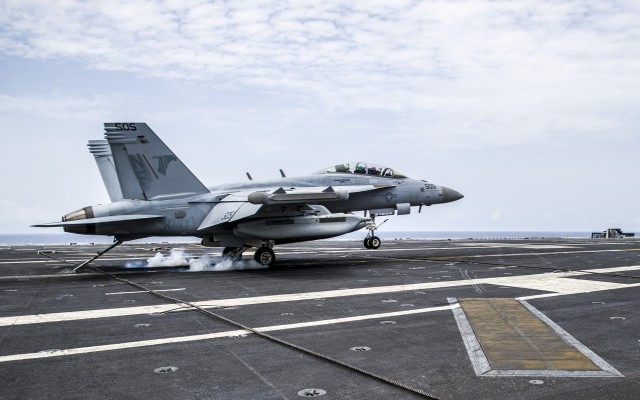
An EA-18G makes an arrested landing on the US Navy carrier USS George Washington – Photo: U.S. Navy – Mass Communication Specialist 3rd Chris Cavagnaro
Whidbey Island has had a long history with aviation. In 1941, the Navy decided to construct a base to help service patrol planes in defense of Puget Sound. That base was called Ault Field, which is now better known as Naval Air Station (NAS) Whidbey Island.
NAS Whidbey is home to planes ranging from P-3C Orion to the C-40A Clipper. The main attraction are the Electronic Warfare aircraft, the EA-18G Growler and the soon-to-be-retired EA-6B Prowler. These aircraft form the backbone of the electronic warfare capability for the Navy and, in fact, all pilots being trained on those aircraft get their start on Whidbey Island.
So what has this got to do with a fun day in spring? On my trip, I got to witness several Growlers performing touch-and-goes, but they were a bit different than those you might see at another airport. They were practicing landing on an aircraft carrier.
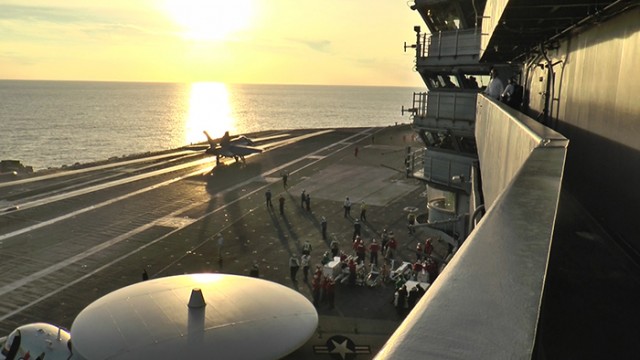
An FA-18 on the USS George H.W. Bush – Photo: The Boeing Company
Landing an aircraft on a carrier has to be one of the toughest jobs for a pilot, and it is probably also extremely exciting. Commonly described as a controlled crash, the process for landing on a carrier seems awfully distressing to crews onboard the ship and in the aircraft. It takes lots of practice, both on land and at sea, to get master the process.
At sea you have to match the pitch and roll of the carrier deck, ensure you are following the correct glide slope, and then, to make things harder, you have to ensure that your jet traveling at speed catches the correct arresting wire (always aim for number 3) otherwise you need to go around again.
Naval aviators get a little hand in the form of the meatball (a specially designed Optical Landing System) and Landing Signal Operators (LSOs). But before they can even attempt to get out to the water to land on a real carrier, they need to learn the process on terra firma.
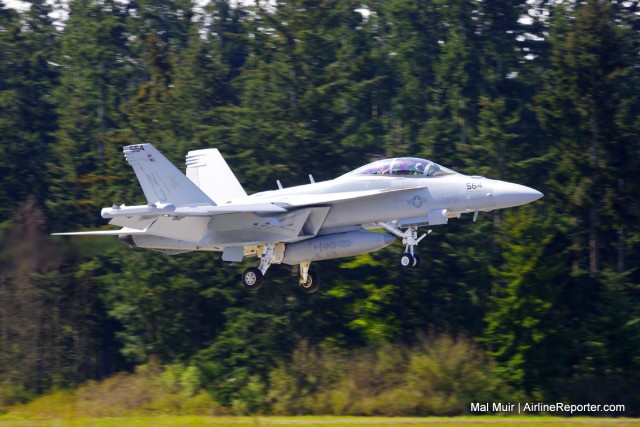
A Growler from VAQ-129 coming into land at NOLF Coupeville; he will be on the ground less than a second before taking off again, performing a touch-and-go.
Called Field Carrier Landing Practice (FCLP for short) this is the time when naval aviators get to practice the process of landing on a carrier, but with a nice long runway that doesn’t move about. This location was designed so that when praciticing, they don’t take up airspace around the naval base.
BONUS: Video from inside the EA-18
The airport (KNRA) is quite bare. It has a control tower, a single runway, and a concrete block fence line that runs around the border. Doesn’t sound like much, but when the Navy comes here for FCLP, they sure do create a show.
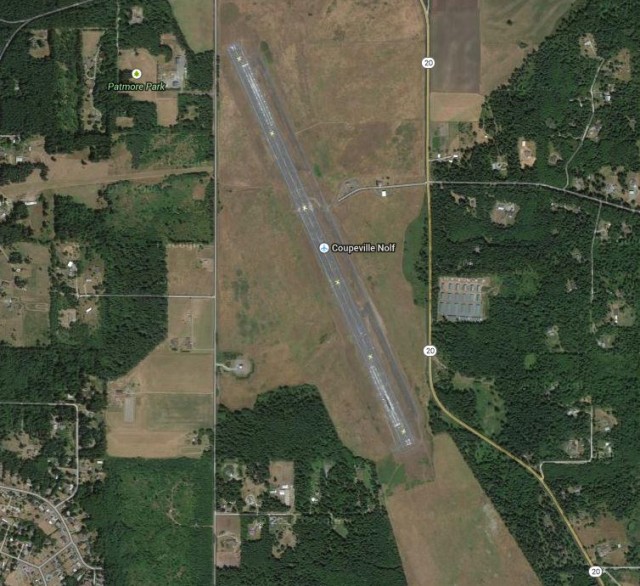
As you can see, NOLF Coupeville is really just a runway. Route 20 is the main road across Whidbey Island – Image: Google Maps
OLF Coupeville is spotter’s dream come true. The field abuts the major road that runs the length of the island and all you need to do is pull off the road safely and walk up to the ’œfence line’. Although with almost any sort of spotting, there is always the chance the police will come and ruin the fun. I didn’t get a visit, but I know other AvGeeks who received a visit from the Washington State Patrol and asked to leave — party poopers.
Since there are no aircraft stored here, there is no high fence to keep people (and animals out). It is just a line of concrete blocks, connected by a big thick steel cable. Signs clearly warn that you are not to cross that line, as it is government property.
What it provides is clear line of sight for when the Navy does show up. Now don’t expect the U.S. Navy to be using this field all day every day — that isn’t the case. We all know that aircraft are loud and the Navy knows this too. So to ensure that the local area residents know when to expect noise, they publish their flight schedule online. Even with the schedule, sometimes planes are still not flying when they are supposed to, so you take a risk when visiting.
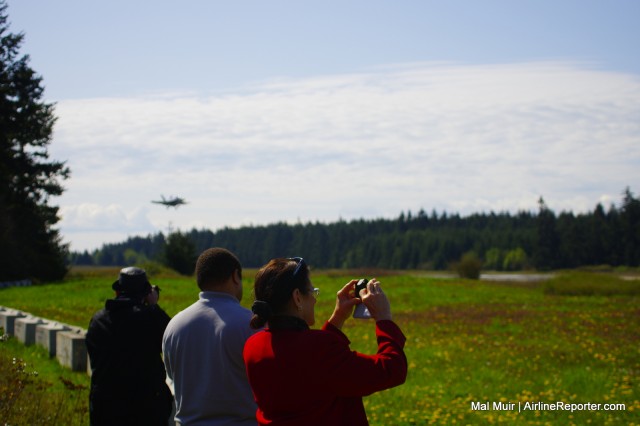
You won’t be the only one taking photos at NOLF Coupeville. Cars will just pull over to the side of the road and people will watch, because deep down we are all AvGeeks.
The day I went up to check things out, I saw that the Navy had scheduled mid-morning to mid-afternoon flights and I was not sure what to expect.
BONUS: Some video of the touch and goes that day
Upon arriving at the OLF (literally turning around a bend in the road and out pops a runway by the side), I took a quick drive around to orientate myself and figure out the best place to take photos.
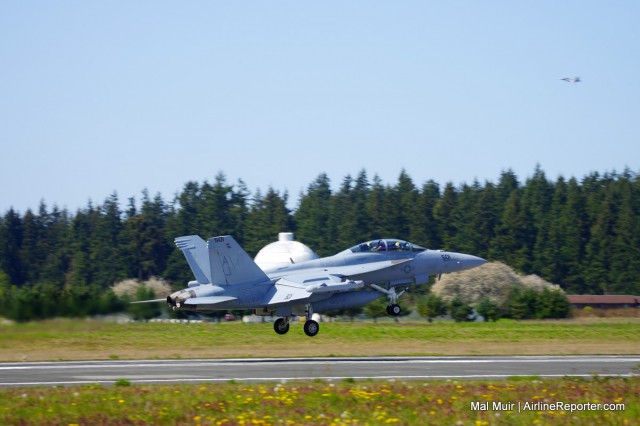
As one Growler conducts a touch-and-go, another one is already in the pattern ready for another shot at recreating a carrier landing
Little did I know that when the first Growler entered the pattern at 10:30 am, it was going to be an amazing day. For three-and-a-half hours, a total of six different aircraft (all EA-18G’s belonging to either the VAQ-129 Vikings or VAQ-131 Lancers) would spend all their time doing touch-and-gos. There was not a time where for more than a few minutes an aircraft was not visible in the sky – it was fantastic.
1,700 photos, three videos, a slightly sun-burnt body, and nearly four hours later, the Navy decided to pack up their show for the afternoon. For my first experience at NOLF Coupeville, I was in awe of what happened. Never before had I seen such displays and this was just a training day for those aviators.
Want more NOLF photos? Check some out from the author and also from our friend avgeekjoe on Flickr.
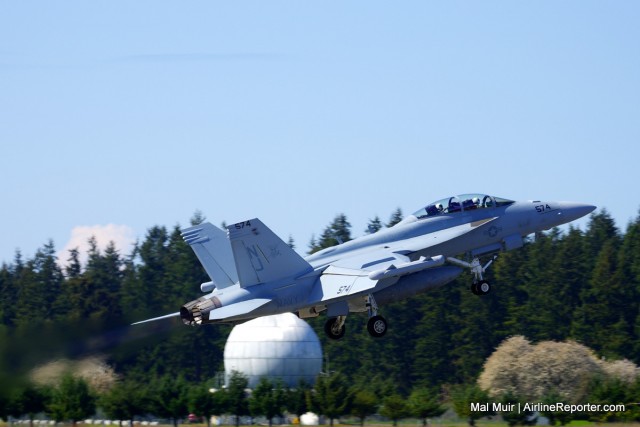
Thanks Mal. A fun report!
Been there and witnessed the fun, more than once. You’re absolutely correct to note that USN does not always follow their published schedule, but that’s not new news. With minimal research, excellent spotting locations can be found, most of which are easy to access, do not violate any security protocols and do not create a trespass situation. Spotter are well advised to do their homework – and reap the rewards. Another tip to bear in mind is that Naval Aviators are not terribly fussy about weather; can and do fly through almost anything. A bright, spring day may create better images for us, but the Navy’s boys and girls do not much care… Nice pix, too!
-C.
Mal, Growler Joe approves :-). Shared the link to this story w/ the Coupeville Chamber of Commerce, the Coupeville Mayor, the Oak Harbor Chamber of Commerce and the Island County Commissioners!!
If you ever find yourself in San Diego, go down to NOLF Imperial Beach to view the goings on for the helicopter side of the house. The slower pace of the helo community is compensated somewhat by at many points of the day a high volume of traffic in the pattern on the duty runway and on the pads to the south.
Yes, it’s a great place to watch the EA18G do Field Carrier Landing Practice. There is a problem with this whole thing though. Unknown to the reporter, these Growlers, when doing their FCLPs go right over a housing development that was there long before the Growlers came. They send out 134.2 dBA of noise over a community of families that are seriously affected by this horrible noise. Please visit citizensofebeysreserve.com to find out more about this incredible imposition of navy noise on these poor folks. We in the neighborhood didn’t mind the EA6b, which was the jet that practiced there before, but the Growler has established a new level of intolerable noise that has destroyed our homes and life. While none of us disputes the need for this training, we do feel that this activity would and could be done elsewhere. This “practice” was done elsewhere for a long time a short while ago, proving that this field is not truely needed. People who would like to move are now unable to sell their homes now due to this new noise level. Children are playing baseball right under the turning spot for these jets, these kids are unable to both cover their ears and play ball at the same time. These jets frighten the animals in the area. We have small Community Supported Agricultural farms that are unable to keep their employees in the fields due to this noise. Necessary practice… Yes, our pilots deserve and must practice for theirs is one of the most difficult jobs in aviation, but this should be done elsewhere.
Michael,
I grew up in Oak Harbor — actually in the flight path for the base. I have experienced the A-6, EA-6B, Growler, C-9s, P-3s, and whatever else they have had flying over. When my mom bought her house, she knew where it was located and of course that the type of aircraft could change and/or increase. That was a risk that she took.
Then, when I bought my house, I did so in the flight path of Paine Field, in Lynnwood. Again, very much knowing that the airport could get commercial service and the traffic could increase.
Both times, I knew what could happen with both locations. And felt that yes, sometimes it was really annoying, but for the greater good for the community as a whole.
I feel the same way about the OLF. Yes, it can be annoying for those in the flight path, but it is not new and people were aware going into it.
David, Editor-in-Chief of AirlineReporter
In use since 1943 according to Wikipedia – 72 years of the sound of freedom! Thank you for the link to the flight ops schedule, I’ve tried to find such a thing in the past and been unsuccessful. Great pictures and thank you for the schedule.
OLF was there before almost everyone alive was here. What did you think when you bought your house when they told you there is a airfield right there? Move away and quit bitching about noise! NOBODY cares about you idiot decision to by and bitch.
Mr. Monson and the COER are a small, but very active, group dedicated to shutting down NOLF Coupeville. His protestations that the group didn’t mind the EA-6B ring hollow, as the leader of COER, Ken Pickard, has been engaged in similar efforts for nigh on thirty years.
People who would like to move are now unable to sell their homes now due to this new noise level.
Those same people bought houses knowing the OLF was there, and signed disclosures about the noise levels.
SEVNAV said today the unmanned aircraft is the future. You could become a Naval Aviator if you were 10 years old or older today but probably not after that.
As a small boy during World war 2, I grew up in Seattle’s Mount Baker neighborhood, there was Boeing Field to the West and Sand Point Naval station to the Northeast, which was also a carrier naval base.
I was glad to see the planes, and knew that they where training, to go to battle. As I had an older brother and cousins in the Navy. When I moved to Camano Islands, Rocky Point neighborhood 5 months ago. I could hear the planes taking off and coming overhead. The training is necessary to maintain a strong military, when you have Countries like North Korea. thinking they could destroy our Country. When I hear the planes in the morning, it’s normally after 8 AM